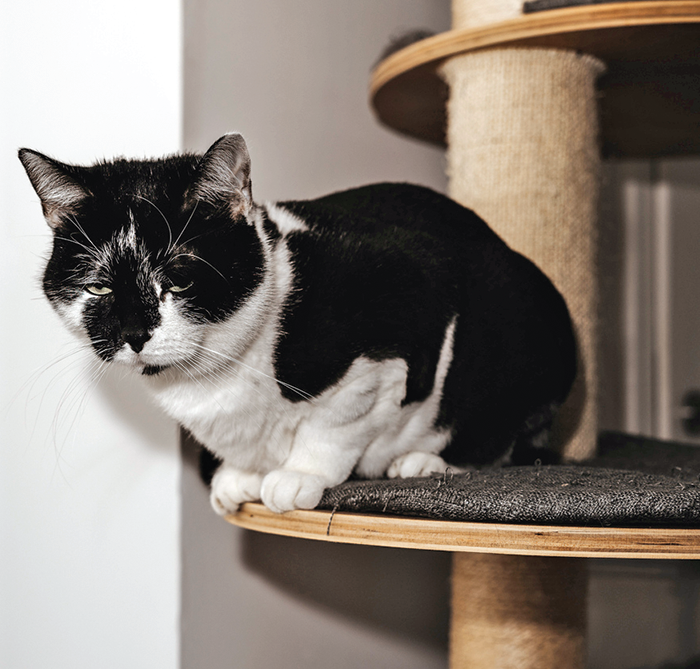Degenerative joint disease, commonly referred to as DJD or simply “arthritis,” is a condition in which the cartilage that normally pads a joint gets worn away. This results in discomfort and loss of mobility. Arthritis can occur in any joint in your cat’s body, from her legs to her neck and back. It can be caused by inflammation from an acute injury, an autoimmune reaction, or simply by the gradual wear and tear.
Arthritis is a concern for cat owners because it can interfere with your cat’s normal activities and causes pain. And your cat may be suffering in silence. Chris Frye, DVM, DACVSMR, CVA, assistant clinical professor of Sports Medicine and Rehabilitation at Cornell University’s College of Veterinary Medicine, says, “The vast majority of cats have evidence of arthritis on exam and x-ray. Cats are unique in their ability to conceal disease; I am sure part of their superpower in that regard is to avoid sending signals to potential predators that they are injured or sick.” The American Association of Feline Practitioners estimates that up to 92% of cats develop arthritis at some point in their lives.
Thankfully, there are things you can do to tell if your cat is one of the many afflicted by arthritis, and to help her stay active and comfortable.
1. Note changes in activity. “Cats with arthritis often do not jump as well as they used to and become less active,” says Dr. Frye. You may notice that your adult or senior cat no longer scrambles to the top of the cat tree or has stopped frequenting her favorite perch on top of the bookcase. Some cats may hesitate before jumping on or off furniture or use intermediate objects as stepping stones instead of jumping directly to the desired spot. Your cat may avoid going up or down stairs, even ceasing to explore an entire floor or upper area of the house.
Other subtle signs of arthritic discomfort include stiffness in the mornings or after getting up from a rest and no longer being as interested in playing as she once was. Your cat may also seem grumpy when picked up or handled or may no longer seek out physical contact. Dr. Frye notes that many senior cats have lower back pain and react negatively when petted there.
While it can be tempting to write these small, gradual changes off as simply your older cat slowing down, they are signs that your cat is in pain.
Your veterinarian can help to figure out where the source of the problem is and determine if pain medications are a good fit for your cat in addition to management at home.
2. Maintain a healthy weight. Keeping your cat in trim condition will do wonders for her mobility and comfort. Excess weight puts extra stress on your cat’s joints, making sore spots without good cartilage cushion even more painful. Your arthritic cat will still need a balanced diet with high-quality protein sources, but if she is overweight, she might benefit from decreased rations or a switch to a lower-calorie diet.
3. Keep resources accessible. Cats with DJD may avoid activity that they once partook in because it is painful. Consider the location of necessities such as food, water, and litterboxes. An arthritic cat may struggle to get up on a counter to access her food and water and may have trouble getting in and out of a high-walled litter box. Move these items to areas your cat can easily reach, or provide an easier route, like a step stool.
For litterboxes, make sure both that your cat can get in and out of the box without issue and that it isn’t too far away. Going up and down stairs or traveling long distances may be painful. Be sure to have a litterbox on each floor of your house that your cat can access.
4. Promote low-impact activity. Inactivity can lead to additional mobility challenges for your cat. Her muscles will atrophy and shrink if they are not being used, which will make her weaker. Joints that don’t use their full range of motion will become restricted over time and eventually be unable to flex and extend as much as in a young cat.
You can help to combat these issues by encouraging your cat to be active in ways that are low-impact and don’t put unnecessary strain on her affected joints. Instead of dangling a toy so that she jumps for it, hold it just high enough that she balances on two or three legs to bat at it. When playing chase games, move the toy slowly so your cat can choose a speed of pursuit that is comfortable for her. If your cat is harness and leash trained, take her for leisurely walks in your yard.
For the food-motivated cat, you can encourage low-impact exercise by arranging her food or treats in a trail that she must follow (just remember to lock up any other pets so they don’t steal her food!). You can also teach her to do tricks such as shake paws, high-five, and placing her front feet up on a box to encourage her to gently stretch and use her limbs.
5. Consider using a joint supplement. Glucosamine and chondroitin are the workhorses of joint supplements in dogs, and cats have options, too! Ask your veterinarian for a cat-safe option to help combat inflammation and promote cartilage rebuilding in your arthritic cat.




